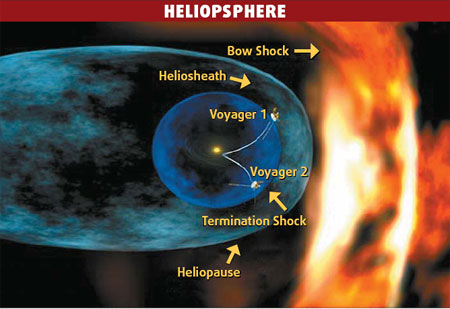Sun less blustery than before
|
In this graphic released by NASA on Tuesday, the heliosphere created by solar winds is depicted as a bubble surrounding the solar system. As the solar wind weakens, more cosmic radiation, super high-energy electrons and protons are allowed through interstellar space, to reach the inner solar system. Reuters |
The sun's winds are less blustery than they used to be, NASA said yesterday, revealing data from a solar probe that promises new insights about Earth's local star but poses few if any consequences for humans, unless you are an astronaut.
The data show the solar wind, a steady stream of charged sub-atomic particles emitted by the sun and blowing at 1.6 million km/h, has dwindled to its lowest level in at least 50 years, reducing its strength as a shield against potentially harmful galactic cosmic radiation.
The solar wind inflates a massive protective bubble, called the heliosphere, around the solar system. But measurements from the spacecraft Ulysses show the wind's pressure has dropped 20 percent since the mid-1990s. At the same time, the electron temperature of the solar wind has declined 13 percent.
As the solar wind weakens, the heliosphere is expected to dwindle in size and strength as well, allowing more cosmic radiation, super high-energy electrons and protons zipping through interstellar space, to reach the inner solar system.
Scientists studying the phenomenon insist Earth's inhabitants have nothing to fear. Humans remain protected from cosmic rays by virtue of the magnetic field that surrounds Earth, acting as an inner barrier to our exposure.
A diminished solar wind and corresponding rise in cosmic rays are of concern, however, to astronauts who venture beyond Earth orbit to the moon, Mars or beyond, and to engineers who design trans-orbital spacecraft.
The biggest implications, however, are scientific ones. Researchers say the findings open the door to a greater understanding of the sun and heliosphere by altering solar conditions in a way that allows scientists to conduct new comparative studies.
"The heliosphere is our laboratory," said Nancy Crooker, a research professor at Boston University, in a conference call with reporters. "We know the sun has been this cool, this inactive before, but that was prior to the space age. So we didn't have actual physical measurements until now of such periods."
Ed Smith, NASA's project scientist for Ulysses, said, "It's an opportunity for us to study changes in the sun which will give us newer insights into the origin of the solar wind and its relation to the solar magnetic field."
The weakening solar wind differs from the 11-year cycles of solar activity associated with such phenomena as sun spots and solar flares that can cause disruptions of electric power grids and radio transmissions on Earth, as well as auroral displays.
However, Dave McComas, a principal Ulysses investigator from the Southwest Research Institute in San Antonio, Texas, said continued diminishment of solar winds could dampen the impact of the next peak in other solar disturbances.
Ulysses, a joint project of NASA and the European Space Agency, was launched from the space shuttle Discovery in 1990 and became the first probe to fly around the sun's poles.
Agencies
(China Daily 09/25/2008 page10)















